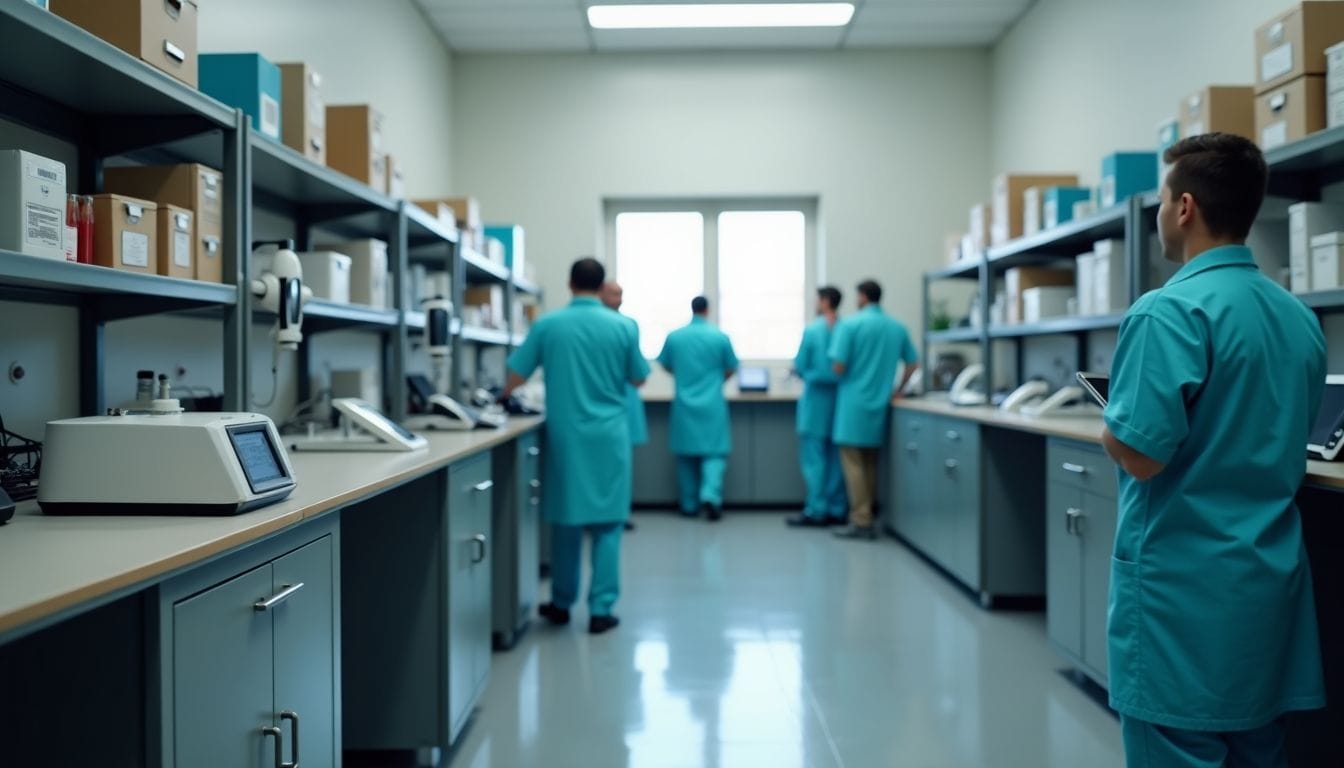R&D Tax Credits Medtech
R&D tax credits in MedTech help companies save money on new ideas. You can get back some cash for trying to make better medical devices or treatments.
Definition and Purpose
Research and development tax credits help spark new ideas in medical technology. They give you money back for your research costs. These credits make it easier to turn fresh ideas into real products.
If you’re a small or medium business, you can get up to 27% of your research spend back. If you’re not making a profit, you’ll get a 27% cash refund. Firms that are making money can claim 21.5% as a tax credit.
This money is yours to keep – you don’t have to pay it back.
These credits give you extra cash without giving up any of your company. They help you work on new medical tools and tech. You can use this money to grow your business and make more health fixes.
Eligibility Criteria for MedTech Companies
MedTech firms must meet set rules to get R&D tax credits. These rules make sure only real new ideas get rewards.
- Your firm must be a UK limited company
- You need to spend money on R&D work that fits the rules
- Your work must try to move science or tech forward
- Projects should not have a clear outcome
- You must keep good records of R&D work and costs
- Making new medical tools counts as R&D
- Making test tools better also counts
- Your research can’t have a clear path to success
- Work on health tech you can wear may count
- Making new drugs or treatments often fits the rules
- Making patient care better with tech counts too
- Small and medium firms can claim up to 33% of R&D costs
- Big firms use a different plan called RDEC
- You can claim for staff costs, items, and some other costs
- Drug tests often count as R&D work
- From 1 April 2024, there are new limits on overseas R&D costs

How Do R&D Tax Credits Benefit MedTech Firms?
R&D tax credits boost MedTech firms’ cash flow. They also spur innovation by cutting costs for new product development.
Financial Advantages
R&D tax credits give big money perks to MedTech firms. You can get back up to 33% of what you spend on R&D. MedTech firms claim £68,000 on average each year. The money is yours to keep and use as you like.
You don’t have to pay it back or give up any control.
These credits help protect your current projects. They free up money for more research, new staff, or better tools. Big firms can get back 20% of R&D costs through the RDEC Scheme.
The MedTech sector makes £22 billion each year. These credits play a big part in helping new ideas and growth.
Impact on Innovation and Growth
R&D tax credits boost innovation in medical tech firms. They help speed up product growth and tech progress. These credits free up money for new work, so you can take more risks. Your firm can grow faster and stay ahead of others.
The numbers show big results. In 2019-2020, 82,950 UK firms claimed R&D tax credits. These firms make more new products than others. For medical tech, the effects are huge. Over 32,000 European medical tech firms use these credits.
They give jobs to more than 730,000 people. This growth helps push medical progress forward.
Your profits will grow too. If you’re making money, you can claim up to 21.5% as a tax credit. For firms losing money, it’s even better. You could get cash back of 27% on R&D costs.
This extra money can fund more study, hire smart people, or buy new tools. It’s a loop that keeps your firm growing and making new things.

Which MedTech Activities Qualify for R&D Tax Credits?
MedTech firms can claim R&D tax credits for a range of activities. These include developing new medical devices, improving diagnostic tools, and creating innovative healthcare software.
Eligible Research and Development Projects
R&D tax credits help new MedTech projects. You can claim for many tasks that push science or tech limits.
- Making new medical tools: Design and test new tools to find or treat illness.
- Making software: Create apps or programs to watch health or study data.
- Looking at new stuff: Find new things to make implants or fake body parts.
- Better ways to give drugs: Make ways to help the body take in or target medicine.
- Making test tools better: Upgrade tools to be more right or fast.
- Making things work better: Make it easier to make or test medical items.
- Using AI and smart tech: Use these to look at health info for better results.
- Better wearable tech: Make new health trackers or tools to watch from far away.
- Robots in health care: Make robot helpers for surgery or patient care.
- Biotech study: Look into gene fixes or ways to make medicine just for you.
- Using 3D printing: Make ways to create custom medical parts or tools.
- Tiny tech in medicine: Study very small tech for exact treatments or tests.
Excluded Activities
R&D tax credits don’t cover all work in a business. Here’s a list of tasks that don’t count:
- Daily tasks: Regular upkeep or quality checks aren’t included.
- Market studies: Surveys or looking at rivals don’t fit R&D rules.
- Office work: Paperwork or staff duties aren’t part of R&D.
- Selling efforts: Ads or branding don’t count as R&D.
- Look changes: Just making things look nicer isn’t R&D.
- Selling products: Getting items ready to sell isn’t R&D.
- Normal work: Common jobs in your field aren’t R&D.
- Basic upgrades: Changes not linked to science don’t count.
- Getting info: Just gathering facts isn’t R&D on its own.
- Teaching staff: Training on current methods isn’t R&D.

What Documentation Is Required for MedTech R&D Tax Claims?
You need to keep good records for your MedTech R&D tax claims. These include project plans, lab notes, and test results.
Essential Records and Evidence
Keeping good records is key for R&D tax claims. You’ll need project charts, drawings, and test results. Photos of models also help. These items show what you’ve done to HMRC.
Clear plans boost your claim’s success. Write down your project’s scope. Get expert views too. This proves your work meets R&D rules. HMRC may want to see your site or check your models.
Solid proof backs up your claim. Track all costs tied to R&D work. Save receipts for stuff and tools. Log staff hours on projects. These details help you get the most from your claim.
Good records make the process smooth and quick.
Best Practices for Documentation
Keep good records of your research projects. Write down all steps, from first plans to end results. This includes notes from meetings, lab reports, and test data. Store these papers safely for at least six years after you claim.
Use computer tools to track your research spending. This makes it simple to sort costs by project and type. It also helps you find costs you can claim quickly. Make sure your records follow tax rules for the best chance of success.

How Are R&D Tax Credits Calculated for MedTech Companies?
You can get R&D tax credits based on your MedTech company’s spending. HMRC looks at costs like staff wages, materials, and clinical trials to work out your claim.
Qualifying Expenditure Categories
R&D tax credits in MedTech cover key spending areas. These groups help firms spot costs they can claim.
- Staff Costs: This covers pay, wages, and pension money for workers doing R&D tasks. It’s often the biggest part of R&D tax claims.
- Subcontractor Costs: Fees paid to outside experts for R&D work can be claimed. This is for jobs given to specialists or research partners.
- Outside Workers: Costs for temp staff hired for R&D tasks can be claimed. This covers their pay and related costs.
- Used-up Items: Things used up in R&D can be claimed. This includes items like chemicals, test samples, or model parts.
- Software Costs: Money spent on software used in R&D can be claimed. This covers both ready-made and custom-made software tools.
- Clinical Trial Costs: Money paid to people in medical studies can be claimed. This is key for MedTech firms testing new devices or treatments.
- Power and Water: Some costs for power, water, and fuel used in R&D can be claimed. The amount must be fairly worked out based on R&D use.
- Some Big Buys: Some spending on fixed items for R&D may qualify. This includes special gear or spaces used only for research.
Calculation Methods and Rates
R&D tax credit calculations involve specific methods and rates. For SMEs, you can claim up to 33% of your qualifying R&D costs. This rate applies to accounting periods before 1 April 2024.
The amount you get back depends on whether your company is profitable or loss-making.
From 1 April 2024, a new merged scheme will kick in for all company sizes. Under this scheme, the expenditure credit rate starts at 11% but will rise to 15% in the future. Loss-making R&D intensive SMEs will get extra support too.
These changes aim to boost innovation across the UK’s growing industries.
To maximise your claim, keep detailed records of all your med-tech projects. Track staff time, materials used, and subcontractor costs. RD Tax Credits UK can help you identify eligible activities and optimise your claim.
Their 98% success rate ensures you get the most from the credit scheme.

What Are the Recent Changes in R&D Tax Credits Affecting MedTech?
Recent changes to R&D tax credits have shaken up the MedTech world. New rules affect how firms can claim and what counts as R&D, so it’s key to stay up-to-date.
Policy Updates
Changes are coming to R&D tax relief in April 2024. These changes will affect both small and large firms. The new rules will cut back on costs for overseas workers. Smaller firms that make money will see their relief rates fall from 130% to 86%.
But it’s not all bad news. From April 2024, cloud computing costs can be part of R&D tax relief. These updates aim to boost UK ideas while keeping costs in check.
You’ll need to get used to these new rules fast. The changes affect how you claim and what you can claim for. It’s key to stay up to date and change your R&D plans. These updates could change your tax perks and overall R&D budget.
Keep an eye on your cloud computing costs – they’ll soon be worth a lot for your claims.
Industry Specific Considerations
MedTech firms face special tax credit issues for R&D. They often can claim for software and hardware work, better processes, and better data tools. From 1 April 2023, cloud work and data sets now count as R&D costs.
This change helps MedTech firms create new things faster and for less money.
The Thames Valley is a top spot for MedTech growth in the UK. Firms here can use lots of skilled people and good tools. It’s key to make more MedTech items in the UK for our health care.
R&D tax credits help with this goal. They let firms spend more on making things here and coming up with new ideas.

How Can MedTech Startups Leverage R&D Tax Credits?
MedTech startups can boost their cash flow with R&D tax credits. These credits help new firms fund more research and grow faster.
Strategies for Early-Stage Companies
Early-stage MedTech firms can boost their R&D efforts with clever tax plans. Here are key ways to use R&D tax credits:
- Track costs early: Write down all R&D spending from the start. This means staff pay, materials, and outside help fees.
- Find good projects: Focus on work that tries to fix tech problems or make new things. This could be making new medical tools or making old ones better.
- Keep good notes: Write down your R&D steps, even the ones that fail. This helps prove your work to the tax office.
- Use online tools: Pick digital systems to store and sort your R&D data. This makes it easier to file claims and get them right.
- Hire smart people: Bring on team members who know science or tech. You can often claim their pay as R&D costs.
- Work with unis: Team up with schools on research projects. This can grow your R&D work and possible claims.
- Ask for grants: Look for cash to fund your R&D. You can often claim many of these with tax credits too.
- Think about patents: Plan how your R&D might lead to patents. The patent box plan gives extra tax perks on money from patented ideas.
- Get expert aid: Work with R&D tax pros who know MedTech. They can help you claim more and follow the rules.
- Keep up with changes: Watch for new R&D tax credit rules. Recent updates have changed how small firms can claim.
Common Pitfalls to Avoid
Medtech firms often make mistakes when claiming R&D tax credits. Here are key pitfalls to avoid:
- Missing the deadline: File your claim within two years of your accounting period’s end. Late claims get turned down.
- Ignoring eligible costs: Don’t overlook cloud computing and data licences. These now count as qualifying expenses.
- Weak evidence: Keep clear records of your R&D work. Include both financial docs and tech details.
- Wrong scheme choice: Pick the right R&D scheme for your company size. SMEs and large firms have different options.
- Poor project definition: Clearly show how your work aims to solve tech issues. Vague descriptions won’t do.
- Skipping expert help: R&D tax rules are complex. A specialist can boost your claim’s success rate.
- Underclaiming: Don’t be shy about your R&D spend. Include all valid costs to get the most benefit.
- Mixing up time periods: Only claim for R&D done in the right tax year. Mixing years can lead to errors.
- Forgetting failed projects: Even if your R&D didn’t work out, you can still claim. Don’t miss out on these costs.
- Overlooking staff costs: Include wages, NI, and pension payments for R&D staff. These often form a big part of claims.

What Are the International Perspectives on MedTech R&D Incentives?
Different countries offer varied R&D tax breaks for MedTech firms. The UK’s scheme stands out for its generous rates, but other nations are catching up fast.
Comparison with Other Countries
R&D tax breaks differ across nations. Here’s how MedTech R&D tax credits compare in various countries:
| Country | R&D Tax Credit Rate | Key Features |
|---|---|---|
| United Kingdom | Up to 33% for SMEs | – Cash credits for firms making a loss – Covers staff costs, materials, and subcontractors |
| France | 30% up to €100 million, 5% above | – Quick refund for SMEs – Includes salaries, supplies, and kit |
| United States | 20% federal credit | – Extra state credits on offer – Covers wages, supplies, and contract research |
| Canada | 15% federal credit | – Higher 35% rate for small CCPCs – Includes salaries, materials, and overhead |
| Australia | 43.5% for SMEs, 38.5% for large firms | – Can be refunded for SMEs – Covers staff costs, consumables, and contracted spend |
In 2021, 33 out of 38 OECD nations gave tax breaks for business R&D. These breaks made up 55% of total R&D support in OECD countries. The UK’s scheme stands out. It focuses on SMEs and cash credits for firms making a loss. This plan aims to boost new ideas in the MedTech field.
Global Competitiveness in MedTech Innovation
The UK is a top player in medical tech worldwide. In 2021, it sold over £5.6 billion worth of products to other countries. UK firms make new tools like wearable devices and machines that spot health issues.
They want to help people get better and make health care cheaper.
Europe is very good at making medical tech. UK firms are a big part of this success. They give jobs to more than half the people who work in life sciences in the UK. These workers come up with new ideas.
This helps the UK stay strong in the field. Smart use of tax breaks for research helps firms keep up in the fast-moving world of medical tech.

How to Maximise R&D Tax Credit Claims in MedTech?
Want to get the most from your MedTech R&D tax credits? You need smart strategies and expert help. A tax pro can spot hidden chances and boost your claim.
Optimisation Strategies
Boost your R&D tax credit claims with clever plans. Start by tracking all your costs closely. This includes staff time, materials, and even failed projects. Keep good records of your work.
This will help you claim more and not miss out on money.
Use tech to help you. Special software can help you log R&D work easily. It can also spot costs you might have missed. This way, you’ll catch more of your spending. You’ll also have better proof for your claims.
Get expert help to get the most benefits. Tax rules change often. Experts stay up-to-date with these changes. They can spot chances to claim that you might miss. They also know how to show your work in the best way.
This can lead to bigger tax savings for your medtech firm.
Working with Tax Specialists
Tax specialists can boost your R&D claims. They know tax rules inside out. These experts guide you through the process and make sure you have the right papers. They’ll help you spot all the costs you can claim.
Picking the right specialist matters. Look for ones who know your industry well. They should explain things clearly. Good specialists stay up-to-date with new rules. They can tell you about recent changes that affect your claim.
RD Tax Credits UK has a great track record. They’ve helped clients get back £120 million. Their method has a 98% success rate. You’ll work with pros who write for top money magazines.
They also speak at big business talks. This means they really know their stuff.
Conclusion
R&D tax credits fuel MedTech innovation. You can boost your company’s growth with these incentives. RD Tax Credits UK helps you maximize your claims. Act now to secure funding for your next breakthrough.
Your ideas could transform healthcare – don’t miss out on this opportunity.

